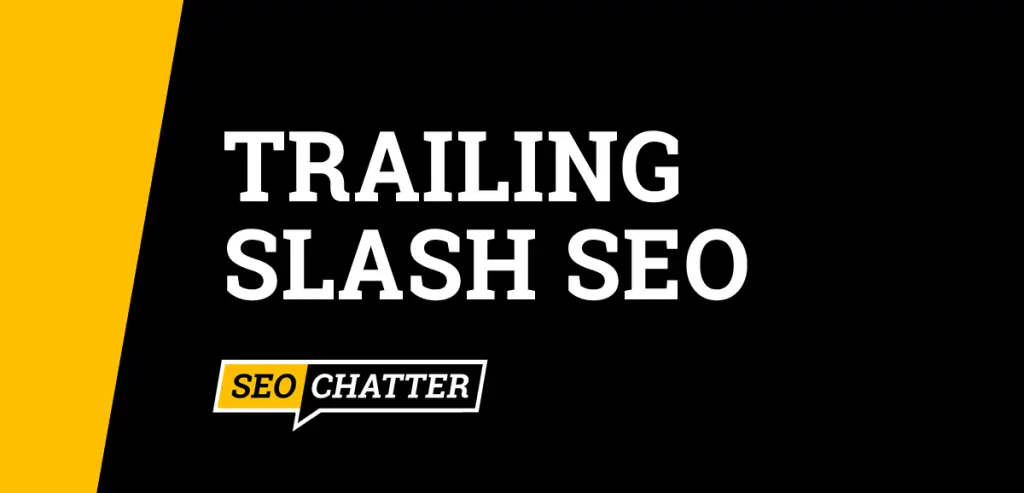This guide covers trailing slash SEO.
Below, you’ll find out how a trailing slash impacts a website’s search engine optimization performance on Google as well as the top issue a forward slash (/) at the end of a URL can cause for web pages. Addtionally, you’ll get a list of tips and best practices on using a trailing slash in URL for SEO so you can improve your sites rankings and crawling by search engine spiders.
Consider this your quick guide to the trailing slash and SEO.

Trailing Slash SEO
A trailing slash in SEO can cause issues with duplicate content, link equity, and crawling if not dealt with correctly on a website. Optimizing the trailing slash for SEO is important for improved organic rankings and search engine visibility.
Does Google Care About Trailing Slashes?
Google does not care about trailing slashes and treats each URL separately (and equally) regardless if it contains a trailing slash or not in the URL. Google sees two versions of the content if the trailing slash is not properly redirected to the preferred version.
If you want your website to have the best results in Google’s search engine results pages (SERPs), then you should set a preferred format for the trailing slash as discussed later in this guide.
Do Trailing Slashes Affect SEO?
Trailing slashes do affect SEO and can lead to ranking issues in search engines for duplicate content without the trailing slash in the URL. Incorrectly using the trailing slash also has a significant influence on SEO for off-page ranking signals and website crawl budgets.
Duplicate Content Impact
If both the trailing slash and non-trailing slash versions of a web page contain the same content, and each returns a 200 response code, then it’s considered to be duplicate content. Duplicate content means you have two URLs competing for the same keywords in Google’s search engine. Not only is that bad for SEO, but it’s also a poor experience for the user.
PageRank Impact
Google’s search engine uses PageRank to measure a web page’s popularity and importance for its target keywords. And PageRank is determined by off-site search engine optimization signals in the form of backlinks.
However, PageRank value can become an issue for a website when there are two versions of the same page on the domain (with and without the trailing slash). If half of the backlinks are pointing to the URL with a trailing slash and the other half to the URL without it, then the link equity will be split; resulting in lower PageRank value for SEO.
Crawl Budget Impact
Google has a finite number of resources, therefore, every website has its own set crawl budget that cannot be raised or lowered by the site owner. That means you need to improve your website’s crawl efficiency as much as possible to get the maximum number of URLs crawled on the website on each Googlebot visit. Otherwise, new content or updated content may be missed and not properly indexed or ranked for users to find in the SERPs.
Google recommends that you fix any duplicate content issues with trailing slashes to improve your site’s SEO crawling performance. You can do this through the content management system (CMS) settings, .htacess file, or a cananoical link tag.
Tips On Using a Trailing Slash In URL for SEO
- Adding a trailing slash at the end of URLs is the preferred format for website content.
- Website owners can choose to use either version they like: with or without the trailing slash. However, URL structures should be consistent to avoid confusion or future issues.
- Always use the preferred version of the URL in internal links.
- If both trailing slash and non-trailing slash versions contain the same content, then use a 301 redirect to resolve the preferred version for the user and search engines.
- If a 301 redirect is not possible, then use a canonical link tag (
rel="canonical") in the HTML head section of the duplicate page to point to the preferred version.
Here’s an example of the HTML code for setting up a proper canonical link tag:
<link rel="canonical" href="https://domain.com/directory/" />If you want to learn more about trailing slashes on website URLs, then check out this other guide on trailing slash. It goes more in depth about the importance of trailing slashes as well as various ways to use WordPress, .htaccess, and canonical tags to set up proper redirects for SEO.
Trailing Slash SEO Summary
I hope you enjoyed this guide about trailing slash SEO.
As you discovered, the trailing slash in search engine optimization can have a big impact on Google rankings if it’s managed incorrectly. Therefore, you should pick a preferred version for the forward slash at the end of URL (with or without it) and stick with that format throughout the website for improved SEO.

SEO Chatter is dedicated to teaching the fundamentals of search engine marketing to help marketers understand how to increase organic website traffic and improve search engine rankings.
